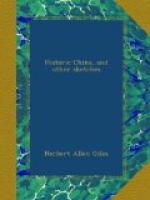their own ends and deceive others; therefore, always
wash out the basin you are going to use or buy a
new one from a shop. Thus the trick will be
defeated.
“The above method of dropping blood on the bones may be used even by a grandchild, desirous of identifying the remains of his grandfather; but husband and wife, not being of the same flesh and blood, it is absurd to suppose that the blood of one would soak into the bones of the other. For such a principle would apply with still more force to the case of a child, who had been suckled by a foster-mother and had grown up, indebted to her for half its existence. With regard to the water method, if the basin used is large and full of water, the bloods will be unable to mix from being so much diluted; and in the latter case where there is no water, if the interval between dropping the two bloods into the basin is too long, the first will get cold and they will not mix.”
Not content with holding an inquest on the bones of a man who may have been murdered five years before, a Chinese coroner quite as often proceeds gravely to examine the wounds of a corpse which has been reduced to ashes by fire and scattered to the four winds of heaven. No mere eyewitness would dare to relate the singular process by which such a result is achieved; but directions exist in black and white, of which the following is a close translation:—
“There are some atrocious villains who, when they have murdered any one, burn the body and throw the ashes away, so that there are no bones to examine. In such cases you must carefully find out at what time the murder was committed and where the body was burnt. Then, when you know the place, all witnesses agreeing on this point, you may proceed without further delay to examine the wounds. The mode of procedure is this. Put up your shed near where the body was burnt, and make the accused and witnesses point out themselves the very spot. Then cut down the grass and weeds growing on this spot, and burn large quantities of fuel till the place is extremely hot, throwing on several pecks of hempseed. By and by brush the place clean, and then, if the body was actually burnt in this spot, the oil from the seed will be found to have sunk into the ground in the form of a human figure, and wherever there were wounds on the dead man, there on this figure the oil will be found to have collected together, large or small, square, round, long, short, oblique, or straight, exactly as they were inflicted. The parts where there were no wounds will be free from any such appearances. But supposing you obtain the outline only without the necessary detail of the wounds, then scrape away the masses of oil, light a brisk fire on the form of the body and throw on grains mixed with water. Make the fire burn as fiercely as possible, and sprinkle vinegar, instantly covering it over with a new well-varnished table. Leave the table on for a little while and then take




